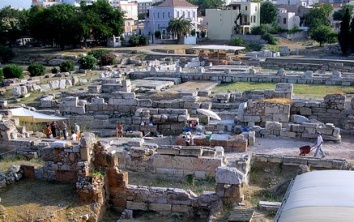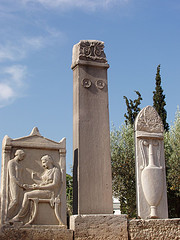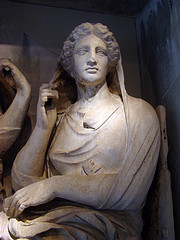

Location: Ermou 148, Thisefo, Athens
Tel. 210 346 3552
Subway: Thisefo
Open: 8:30am- 3pm Tue- Sun
11am- 3pm Mon



Kerameikos is an ancient cemetery of Athens. First burials date back to the 12th century. The Sacred Way that started in Eleusis led here. Most of statues were removed, but their plaster casts stands on its previous location.
In particular, however, the name Kerameikos referred to in Ancient
Athens two districts that were located at the northwest end of Athens at
the time, the so-called "Exo Kerameikos" and "Eso Kerameikos". In other
words, two Potters, as Hesychius says, one outside the wall, the other
inside. This distinction is also mentioned by Plato, Thucydides and
Plutarch. Kerameikos was the first public cemetery of ancient Athens.
These two ancient districts made up the municipality of Keramea,
from the Akamantida tribe. The name of this municipality came according
to some from the named hero Keramos while according to others from the
artisan potters (potters - potters) and from their workshops that were
originally in this area. The two Kerameiki were separated from each
other by the Themistocleian wall (479 BC), and were connected by the
large double gate called "Dipylo" to which the ancient Piraeus road, the
Holy road, from and to the ancient Eleusis and the street to the Plato
Academy. Inside Dipylos, a long avenue started that through the ancient
market and between the hills of Pnyka and Areio Pago ended at the
entrance of the Acropolis. Thus, the Exo Kerameikos had a burial
character, while the Eso Kerameikos had a residential character.
From the Hellenistic period to the early Christian times (338 BC to the
6th century) the cemetery seems to have operated continuously.
The area of Exo Kerameikos was crossed by converging, as mentioned
above, three great ancient roads (roads), the one from Piraeus called
"Piraeus", the one from Eleusis, called "Sacred Road" and the so-called
"Road" known as (h) the Panathenaic Road , to and from Plato's Academy.
In front of the wall and on either side of each of these streets were
the tombs (cemeteries) of ancient Athens, with the result that the
entire area gives the impression of a large cemetery, which was brought
to light by the archaeological excavations that began timidly in 1861,
and officially by 1863 during the reign of King George I, initially by
the Hellenic Archaeological Society and then by the German
Archaeological Institute of Athens where they continue to this day.
This cemetery of Kerameikos is located in the area of the current
church of Agia Triada, on Piraeus Street, in the district of the same
name in Athens and north of the old vegetable market, Gazi area, which
today has been converted into a park and a pedestrian street where the
street ends Ermou on Piraeus Street. The best-preserved part of the
ancient outer Kerameikos today are the private tombs located south of
the church of the Holy Trinity that flanked the end of the Sacred Way
and indeed those on the right side of the entrance from the west.
The oldest tombs of the site date back to the Bronze Age. From the
Sub-Mycenaean period (1100-1000 BC) onwards the Kerameikos cemetery has
been continuously developing. During the Geometric period (1000-700 BC)
and especially during the Archaic period (700-480 BC) the graves
multiply and are included in burial mounds where they are "marked" with
epitaphic monuments. During the Classical period (5th - 4th century BC)
the two roads that approached Dipylos (external and western, i.e. the
one from Piraeus and the Holy Road), were flanked by cemeteries and
funerary monuments, usually family ones, distinguished by burials
monuments. In this area and towards Akadimias Platona Street that passed
next (north) from the current church of the Holy Trinity, the "Public
Sign" was created where it was the burial place of prominent Athenians
as well as the "fallen in war", with character military cemetery.
Double
The Dipylon (named from the double construction) was the
main gate (entrance) of ancient Athens. It was discovered by the
Archaeological Society's excavations in the years 1872-1874. It is
located about 150 meters east of the church of the Holy Trinity and
consists of the outer gate, the corridor (entrance-exit) and the inner
gate.
The outer gate of the wall is flanked by two openings each
3.5 meters wide and protected by two square towers on either side that
protrude 8 meters from the wall.
The courtyard corridor is 47.40
meters long and is formed by the extension of the two walls (legs) of
the wall, inside its main line.
The inner gate located at the end of
the entrance courtyard is almost identical in construction to the outer
gate, in terms of openings and bastions.
But apart from the Dipylus
there was still a smaller gate, the Holy Gate, southwest of the Dipylus
which belonged to the Ceramic Gates of the wall, also fortified, which
Wilhelm Derpfeld considered as an opening for the waters of the ancient
stream Iridanos.
Eso Kerameikos
To the east of the inner gate of the Dipylus and
the Themistocleian wall stretches the Eso Kerameikos, that is, the
district of ancient Athens which constituted its most important part,
which was crossed by the great road, the so-called Panathenaic road,
which was the central road artery of city, according to Imerios "a
straight and smooth road, which descends from above, cuts through the
long arcades on either side of it (Kerameiko) when the Athenians buy".
According to the detailed descriptions of this area by Pausanias,
immediately after the inner gate of Dipylus was the Pompeio and many
other buildings, temples, arcades, public institutions which were
located in the Ancient Agora, which was also the largest and most
important part of the Eso Kerameikos , so much so that the name
Kerameikos is often identified with the Ancient Agora in the texts.
Archaeological site
The approximately 40-acre archaeological site
of Kerameikos was covered until its excavation by embankments 8-9 meters
high, i.e. the current level of Ermou Street. Today the visitor to the
site walks exactly on the same level as the Athenians walked in the
classical era.
During the construction of the "Kerameikos" metro
station, approximately 1,000 tombs from the 4th and 5th centuries BC
were found in the so-called plague pit. The archaeologist Efi
Baziotopoulou-Valavani dated the cemetery to the period between 430 and
426 BC. Thucydides described the panic caused by the plague, possibly an
epidemic of typhoid fever, which struck the city in 430 BC. The epidemic
lasted two years and is estimated to have killed a third of the
population. He wrote that lifeless bodies had been abandoned in temples
and streets, only to be picked up and buried hastily. The disease
reappeared in the winter of 427 BC.
Recent findings at Kerameikos
include the excavation of a Kouros, 2.1 meters high, which was excavated
by the German Archaeological Institute of Athens under the guidance of
Professor Wolf-Dietrich Niemeier. This kouros is twice the size of the
one exhibited in the Metropolitan Museum of Art, New York, and both were
crafted by the same anonymous sculptor, who was called the "craftsman of
the Dipylus." Large sections adjacent to those that have already been
excavated remain to be discovered, as they lie beneath the buildings of
modern Athens. Excavation of these areas has been suspended until funds
are secured.
The current district of Kerameikos
Kerameikos is a district
located between the districts of Koumoundourou Square, Gazi, Thisio,
Monastiraki, Petralona, Metaxourgeio and Psyrri. It got its name from
the Archaeological site of Kerameikos around which it developed. It is
crossed by Piraeus Street and its boundaries are the odd-numbered side
of Thermopylon Street, the even-numbered side of Leonidou Street and the
even-numbered side of Iera Odos in the section between Piraeus Street
and Iera Odos . In the section between Piraeus and Ermou Streets, the
boundaries are the even-numbered side of Agion Asomaton Street, the
even-numbered side of Ermou Street and the odd-numbered side of Sarri
Street. The district is home to the Church of the Holy Trinity and is
served by the Metro and many city bus lines. In the past, one of the
tram stations was located behind the Church of the Holy Trinity.